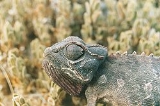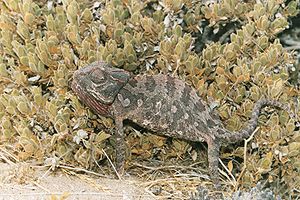
Namaqua Chameleon
Encyclopedia
The Namaqua Chameleon (Chamaeleo namaquensis) is a ground living lizard
found in the Namib Desert
of Namibia
and southern Angola
.
several adaptations to cope with desert conditions; they excrete salt from nasal glands to conserve water, and dig holes to aid in thermoregulation
. They also use their ability to change colour to aid in controlling temperature, becoming black in the cooler morning to absorb heat more efficiently, then a lighter grey color to reflect light during the heat of the day - or showing both colours at the same time, neatly separated left from right by the spine.
s of the genus
Chamaeleo
, its tail is not prehensile, but otherwise it still hunts in the same way, slowly stalking its prey and catching it with its long tongue. Namaqua Chameleons feed on insects (particularly beetle
s), crickets, lizards, including young chameleons of their own species, small snakes, and even scorpion
s, hunting them in both sandy dunes and rocky areas.
s, hawk
s and eagle
s.
Lizard
Lizards are a widespread group of squamate reptiles, with nearly 3800 species, ranging across all continents except Antarctica as well as most oceanic island chains...
found in the Namib Desert
Namib Desert
The Namib Desert is a desert in Namibia and southwest Angola that forms part of the Namib-Naukluft National Park, the largest game reserve in Africa. The name "Namib" is of Nama origin and means "vast place"...
of Namibia
Namibia
Namibia, officially the Republic of Namibia , is a country in southern Africa whose western border is the Atlantic Ocean. It shares land borders with Angola and Zambia to the north, Botswana to the east and South Africa to the south and east. It gained independence from South Africa on 21 March...
and southern Angola
Angola
Angola, officially the Republic of Angola , is a country in south-central Africa bordered by Namibia on the south, the Democratic Republic of the Congo on the north, and Zambia on the east; its west coast is on the Atlantic Ocean with Luanda as its capital city...
.
Survival Techniques
The Namaqua Chameleon has evolvedEvolution
Evolution is any change across successive generations in the heritable characteristics of biological populations. Evolutionary processes give rise to diversity at every level of biological organisation, including species, individual organisms and molecules such as DNA and proteins.Life on Earth...
several adaptations to cope with desert conditions; they excrete salt from nasal glands to conserve water, and dig holes to aid in thermoregulation
Thermoregulation
Thermoregulation is the ability of an organism to keep its body temperature within certain boundaries, even when the surrounding temperature is very different...
. They also use their ability to change colour to aid in controlling temperature, becoming black in the cooler morning to absorb heat more efficiently, then a lighter grey color to reflect light during the heat of the day - or showing both colours at the same time, neatly separated left from right by the spine.
Prey
Unlike the arboreal chameleonChameleon
Chameleons are a distinctive and highly specialized clade of lizards. They are distinguished by their parrot-like zygodactylous feet, their separately mobile and stereoscopic eyes, their very long, highly modified, and rapidly extrudable tongues, their swaying gait, the possession by many of a...
s of the genus
Genus
In biology, a genus is a low-level taxonomic rank used in the biological classification of living and fossil organisms, which is an example of definition by genus and differentia...
Chamaeleo
Chamaeleo
Chamaeleo is a genus of chameleons found primarily in the mainland of sub-saharan Africa, but a few species are also present in northern Africa, southern Europe and southern Asia east to India and Sri Lanka. They are slow moving with independently movable eyes, the ability to change skin...
, its tail is not prehensile, but otherwise it still hunts in the same way, slowly stalking its prey and catching it with its long tongue. Namaqua Chameleons feed on insects (particularly beetle
Beetle
Coleoptera is an order of insects commonly called beetles. The word "coleoptera" is from the Greek , koleos, "sheath"; and , pteron, "wing", thus "sheathed wing". Coleoptera contains more species than any other order, constituting almost 25% of all known life-forms...
s), crickets, lizards, including young chameleons of their own species, small snakes, and even scorpion
Scorpion
Scorpions are predatory arthropod animals of the order Scorpiones within the class Arachnida. They have eight legs and are easily recognized by the pair of grasping claws and the narrow, segmented tail, often carried in a characteristic forward curve over the back, ending with a venomous stinger...
s, hunting them in both sandy dunes and rocky areas.

Predators
In turn, Namaqua Chameleons are preyed upon by jackalJackal
Although the word jackal has been historically used to refer to many small- to medium-sized species of the wolf genus of mammals, Canis, today it most properly and commonly refers to three species: the black-backed jackal and the side-striped jackal of sub-Saharan Africa, and the golden jackal of...
s, hawk
Hawk
The term hawk can be used in several ways:* In strict usage in Australia and Africa, to mean any of the species in the subfamily Accipitrinae, which comprises the genera Accipiter, Micronisus, Melierax, Urotriorchis and Megatriorchis. The large and widespread Accipiter genus includes goshawks,...
s and eagle
Eagle
Eagles are members of the bird family Accipitridae, and belong to several genera which are not necessarily closely related to each other. Most of the more than 60 species occur in Eurasia and Africa. Outside this area, just two species can be found in the United States and Canada, nine more in...
s.

